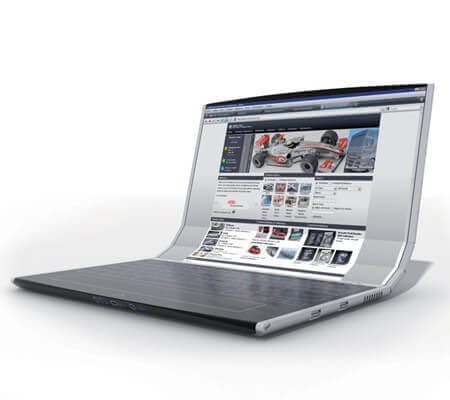Foldable and Wearable Computing approaches Useful Levels of Application
Foldable Computer Concept (From Tuvie.com)
Should computers be foldable? This may seem like a very silly question, but the inkjet industry recently saw a printing breakthrough that has advanced this sort of idea closer to reality. The current focus is on graphene, a material that has widely been considered an excellent choice for the next generation of computing. Graphene is conductive (which is very important for any electronic device) as well as flexible and chemically stable, so it won’t degrade very easily even when used in moderately harsh applications.
However, there have been a number of problems associated with the use of graphene in computing. The first major problem is that graphene can be difficult to create in the sorts of large, pure amounts that are necessary for effective computing. A new production method, however, has resulted in the ability to obtain larger concentrations of high-quality graphene that can be mixed into ink and then printed out in a standard manner, creating a new sort of printed circuit. Even better, this method has kept most of graphene’s valued properties, as well as created something that’s literally hundreds of times more efficient at conducting electricity than previous attempts managed.
Foldable computing probably isn’t going to replace desktop machines any time soon, but some have indicated an interest in it as a way of getting more computing power on the go. We already have the ability to put solar cells into clothing, so adding computers to everything else could create a way to make technology much more portable.
Despite current breakthroughs, a considerable amount of work needs to be done before graphene and flexible computers become a reality, much less useful in a practical manner. For one thing, even if inkjet cartridges are capable of printing better circuits, powerful computers still have a certain degree of weight to them and just can’t be made portable so easily. Smartphones and Tablets have improved their capabilities, but they remain casual devices, unable to do the sorts of things that a real machine is capable of. Part of the process, then, is continuing to focus on developing lightweight but durable materials. Another consideration is impacts; people can trip and fall, bump into others, or even just sit down and lean back against a chair, all of which has the potential to shake up and damage electronics. Many people prefer to keep their machines in padded bags specifically to help avoid damage, and however interesting it might be to have computers in clothing, the possibility for damage over time is something that has to be addressed.
On the bright side, most problems are solved step-by-step. In the larger scheme of things, it wasn’t very long ago that the most impressive computer on the planet took up entire rooms in universities…And even the greatest of those, when compared to modern technology, is less capable than your average smartphone. None of us can truly predict how technology will advance, so even if wearable computers made out of inkjet-printed circuits seems incredible now, it might just be a practical reality before you know it.Get fresh discounts by signing up for our newsletter.

